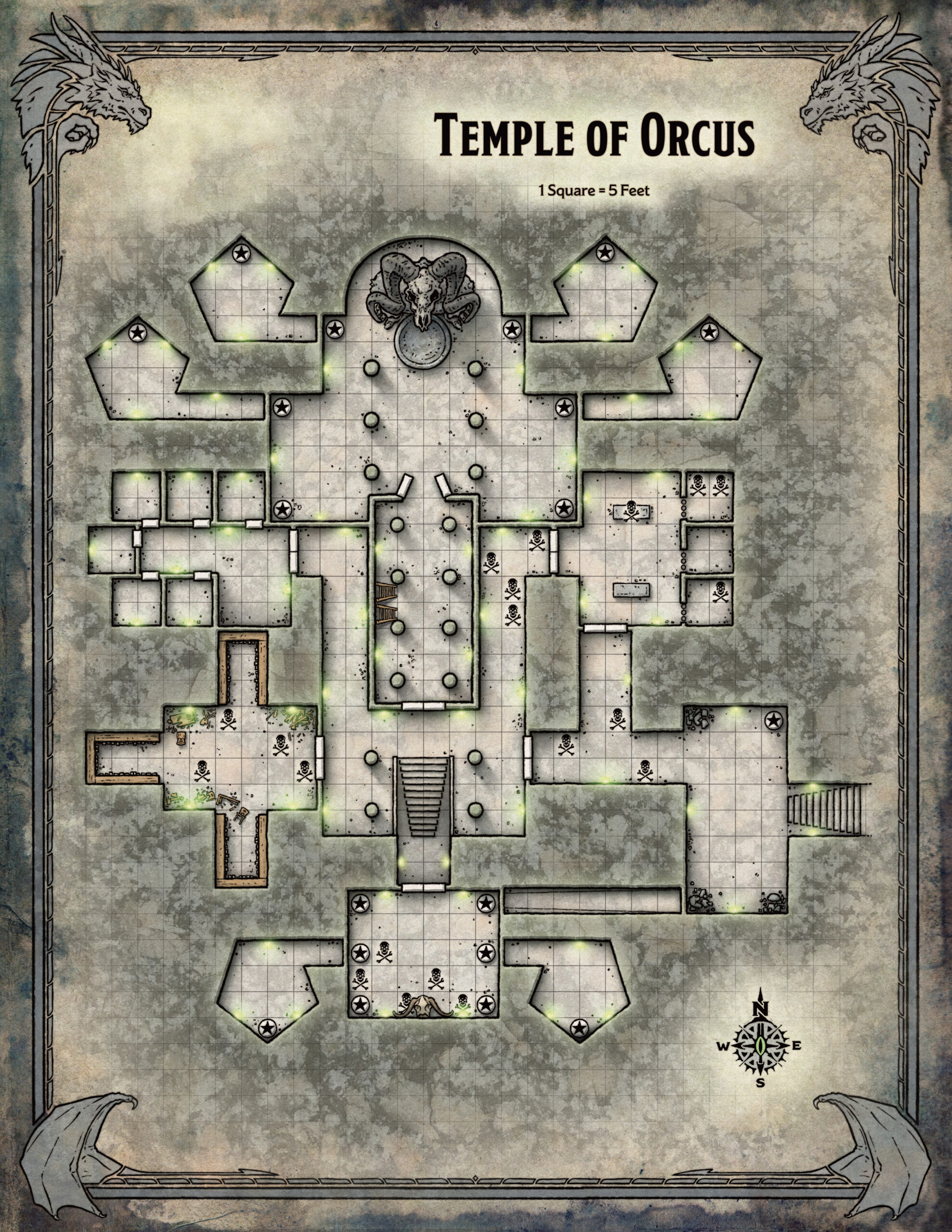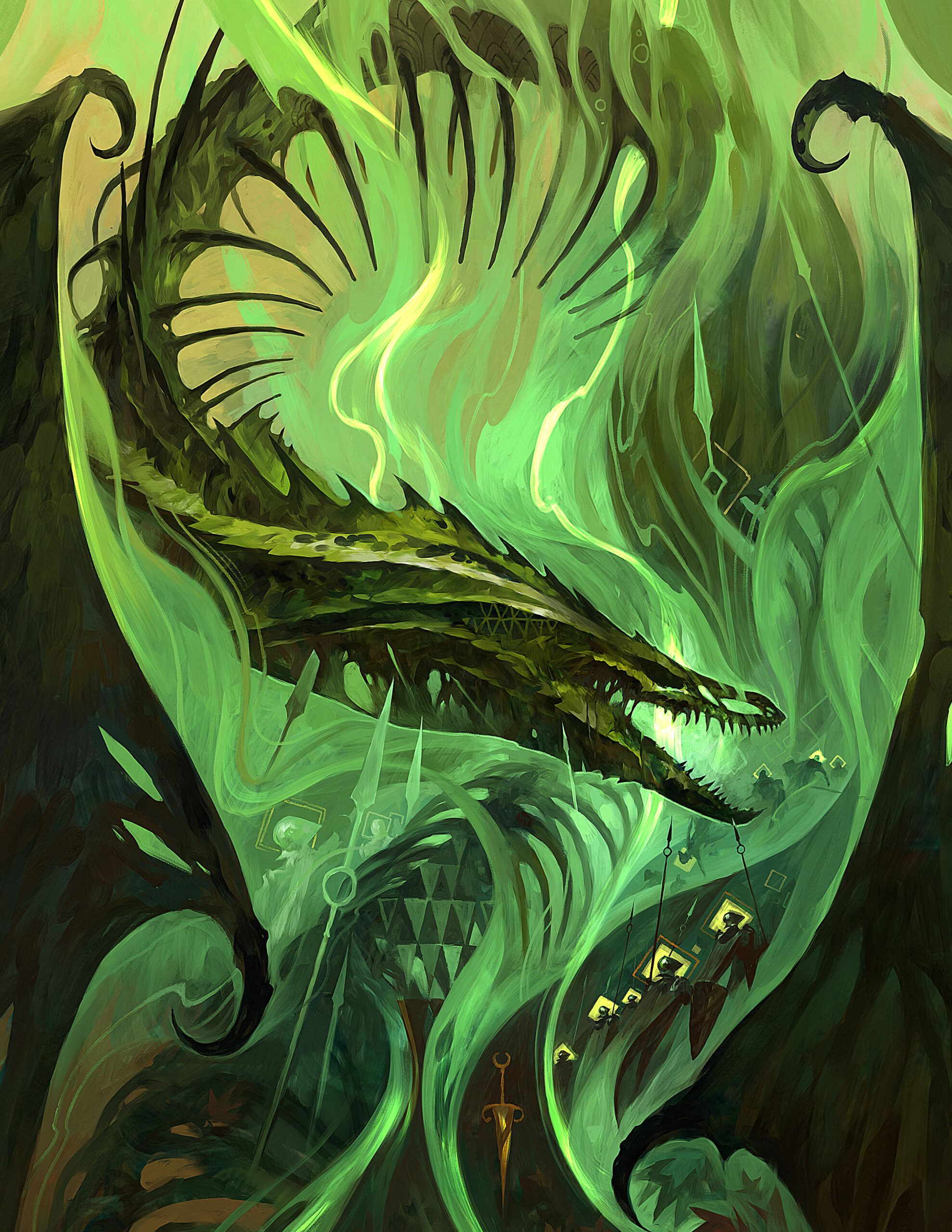As promised, the revised editions are not required to play through Dragon Delves, though they can be used if you wish. In fact, the “Running the Adventure” section in the introduction only specifies that “you need the Fifth Edition core rulebooks” without specifying the 2014 or the 2024 versions.
While dragons have been featured in plenty of prior D&D books—dragons are in the game’s name, after all—this adventure anthology focuses specifically on dragons in their lairs, both chromatic and metallic. My favorite, the gem dragons, are ignored as usual.
The 10 adventures are designed for characters ranging from level 1 through 12, with a range of lair types. The challenges vary from straight up “defeat the bad dragon” scenarios to working with good dragons, and some difficult moral dilemmas in between.
Dragon Delves gives several examples of how and why these adventures could be used as one-shots (The DM can’t make it at the last minute, someone wants to try DMing or testing out if a new group will play well with each other before starting a campaign, adding more adventures to a journey, etc.). It also provides three ideas for how to turn this adventure anthology into a full campaign. Two are solely based on material within Dragon Delves, modified as per the suggestions. The third method involves the earlier book, Fizban’s Treasure of Dragons. That book was developed by James Wyatt, who also handled game design for Dragon Delves along with Amanda Hamon (Phandelver and Below).

Easier DM Preparation
One of the stated goals for Dragon Delves is to make these adventures easy for a DM run on the spur of the moment. After all, sometimes a DM has to work late or a player key to the next segment of a campaign might be sick, etc. Instead of canceling, someone can run a Dragon Delves adventure without much prep time. The key elements have been given in prior adventures but not always consistently. I really hope this format (the prep page) becomes standard going forward.
It starts with a summary of key plot points. Next, it lists the steps the DM needs to take to run the adventure, including a list of all the Monster Manual stat blocks needed so they can be bookmarked in advance. Lastly, key NPCs are listed in a table, providing their names, roles, the stat blocks to use for them and the locations where they can be found.
Dungeon Delves also recommends the Player Assistance options detailed in the DMG. These are ways for players to help the DM by handling some aspects of game management. This is especially useful for new DMs.
The easiest is making a player the combat initiative tracker. My personal favorite is the rules consultant. Back when I was running D&D Adventure League, I referred to one of my players as “DM’s little helper” because he was so fast at finding the page number for anything that had to be double-checked. Since my table size was often larger than preferred due to walk-ins, it was extremely helpful.
Monster wranglers are useful but can be tricky in some groups, if some players are very competitive. One or two players handle the monsters, using the MM stat blocks. So long as everyone is on the same page and no one takes it personally if a monster run by another player does significant damage, it can make things more manageable for a DM.
Adventures Ahoy!
While all of the adventures are designed for the standard party of 4-6 players, three are listed as suitable, with modifications, for a single player and a DM. Those are the 3rd level adventure Baker’s Doesn’t, the 7th level adventure The Dragon of Najkir, and the 12th level A Copper for a Song.
One of the things that makes these viable as a single-player adventure is the supernatural gift (blessing, of course), Blessing of the Lone Champion. The blessing lasts for the length of the adventure and grants temp hit points equal to 10 times your level and Heroic Inspiration upon finishing a long or short rest. That’s definitely a good start. I can’t comment on whether it’s sufficient until I playtest it, but I love that they’re providing the option.
Dragon Delves also directs DMs to the Dungeon Master’s Guide for how to adjust an adventure if your group is larger or smaller than the standard. It also gives the rough idea behind the methods in the new book. PLEASE NOTE: that these summaries contain mild spoilers!
-
- Death at Sunset is for 1st level characters. This adventure is fairly straightforward with a green dragon wyrmling following its late mother’s path.
- Baker’s Doesn’t is for 2nd level characters or can be run for just one player. A gold dragon wyrmling may have caused a fire at a confectioner’s shop and the players are tasked by the dwarf baker raising him with finding the energetic wyrmling and figuring out what happened. How this adventure plays out varies depending on a cascading series of consequences.
- The Will of Orcas is for 4th level characters, and can take place in any areas with mountains and settlements. A mix of investigation and combat, this silver-dragon focused adventure has a nice twist to it.
- For Whom the Void Calls is for 5th level characters, and can take place anywhere there’s a cavern with a stream. It features a bit of deception with a fun twist. This adventure could be very handy for a DM who wants to transition their campaign to Spelljammer, because it can foreshadow that setting.
- Dragons of Najkir is for 7th level characters and can be run for just one player. The players are dispatched to rescue some people shipwrecked at an island monastery by a bronze dragon. More than a standard rescue, the players must make the dragon realize that the person it’s protecting is not worthy of its loyalty.
- The Forbidden Vale is for 9th level characters and will take three to four sessions. Players are hired to stop fires begun by a red dragon, who is also protecting a magical garden. Players can resolve this adventure without killing the red dragon.
- Before the Storm is for 10th level characters. Pirates, egged on by a black dragon, have looted a town, stealing the magic item that protects it from storms. Then ending can vary based on a combination of consequences.
- Shivering Death is for 11th level characters. To end a deadly heatwave, the remains of the frost giant Elakdras are needed to perform a ritual, but that means going into the lair of a cruel white dragon.
- A Copper for a Song is for 12th level characters and is set in Godsbreath, a location introduced in Journeys Through the Radiant Citadel but any coastal town with farmland nearby could be substituted. It can also be run for just one person. Players must find the missing verses to a magical song and can use anything from cajoling to combat to get them from a copper dragon, who is also raising two green dragon wyrmlings.
- Dragons of the Sandstone City is for 12th level characters and can be used, as the book’s introduction explained, as a way to tie all of the adventures into a campaign. The evil blue dragon Anthradusk has killed the brass dragon protector of a subterranean city and is preparing a nefarious ritual using the dragon’s egg. Players can explore the ruins, encountering a sphinx in the process, while working to thwart Anthradusk’s ritual. Failure means that Anthradusk will have more power and allies to terrorize the countryside.
[*]
Reading the credits for this book is a bit bittersweet since both Chris Perkins and Jeremy Crawford have left Wizards for Darrington Press. The book is actually dedicated to Perkins “…for his decades of contributions to Dungeons & Dragons.” I suspect an upcoming book will be dedicated to Crawford.
Perkins was one of the contributing designers along with other veterans like F. Wesley Schneider, Jason Tondro, Makenzie De Armas, Justice Ramin Arman, and more. Makenzie De Armas was lead rule developer along with Crawford and Ron Lundeen. Art credits are especially long due to the inclusion of classic art from prior books by Jeff Easley, Larry Elmore, Clyde Caldwell and many more, plus modern artists like Jabari Weathers, Ed Kwong, Jodie Muir, and so many others.

What I Liked
Adventures designed to be run with minimal prep – that’s something we need more of in today’s busy world. I like the setup that makes that possible. More of that, please.
The book does a great job explaining how to fit these short adventures (mostly taking just one or two sessions) into an existing campaign, both if you’re keeping it basic, and if you want to put in the time and effort to customize the adventures to fit more deeply and seamlessly into your campaign. I also like that there are a variety of ways to succeed instead of them all being focused on hack and slay. There’s plenty of combat opportunities in every adventure, but creative players have room to indulge in other tactics.
The new art is terrific. I began to single out my favorites, but then realized I was on the path to cite all of it. Both covers capture the spirit of the book well, but I actually liked the regular cover more – a rarity for me – over the alt cover. Greg Staples’ regular cover has a terrifying majesty I like. Justine Jones’ alt cover is described as “a psychedelic dream of dragons.” It’s lovely, but doesn’t resonate with me as much.
What Could Have Been Better
Upon opening Dragon Delves, I liked that a different type of dragon was the focus of each adventure. Then I noticed that each chapter ended with “History of [type] Dragons” and was excited. That immediately changed to disappointment worthy of a sad trombone sound effect when I flipped to one of those sections.
To me, “History of Red Dragons” and such sounds like some sort of dragon lore or perhaps info on some notable dragons of that type. In recent years, Wizards has done a terrific job of providing adventure seeds, story information, and other nuggets of ideas that a DM could expand in to their own adventure. A few short profiles of notable dragons or histories of various dragon activity would have fit that mold perfectly and could have been a lot of fun. Instead, the history of dragons in question are retrospectives of past dragon artwork from various D&D books and adventures. Yes, that’s nice, but it’s a letdown. Your mileage may vary.
And while this is less of a “didn’t like” and more of a “disappointed” Dragon Delves doesn’t include any new monsters. Coming so soon after the updated core books, I’m not surprised, especially considering prior release patterns, but one of the fun things in new books is new creatures.
In Summary
If you like dragons and adventure anthologies, Dragon Delves is a no-brainer. It has enough flexibility to fit a variety of DM needs, whether that’s running the adventures as is, raiding them for elements that can be repurposed in other adventures, and so forth. The adventures have enough variety to work for almost any group’s play style.
I give it a solid B+. While I like a lot of the book and how it’s organized to make life easier for a DM, the lack of new creatures, though understandable, and the disappointment over the History of Dragons sections shave off some points. The art retrospective is interesting, but for my taste that space could have been used better.
Read more at this site
